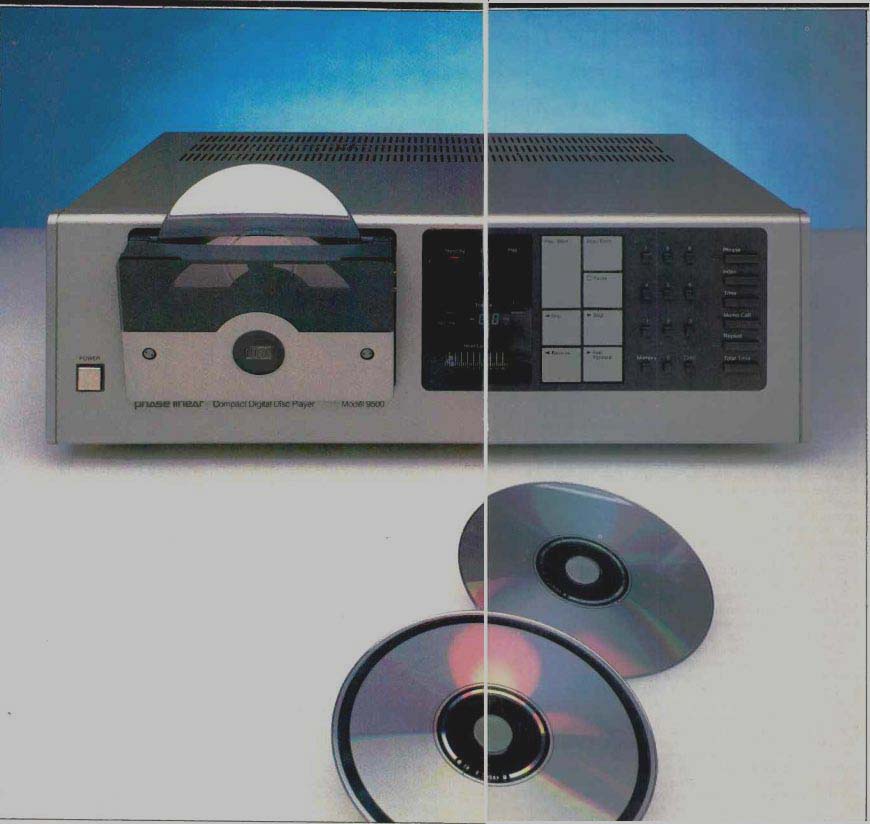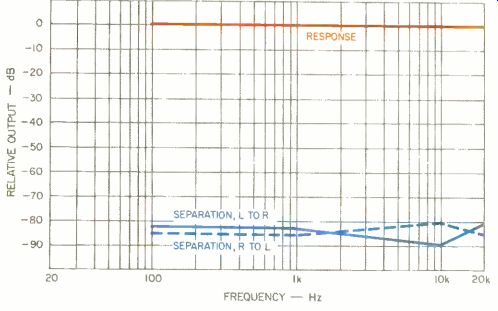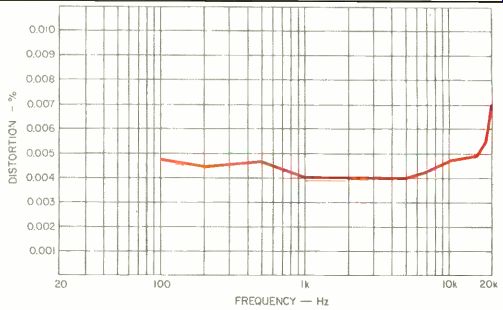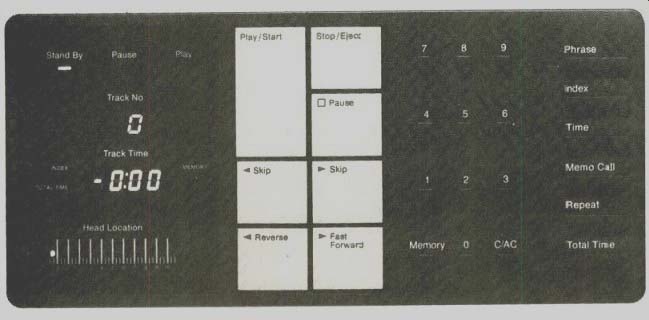
Manufacturer's Specifications
Frequency Response: 20 Hz to 20 kHz, ±0.5 dB.
Dynamic Range: More than 90 dB.
S/N Ratio: More than 90 dB.
Channel Separation: 90 dB.
Harmonic Distortion: Less than 0.005%.
Wow and Flutter: Unmeasurable.
Line Output Level: 0 to 2.0 V, variable.
Output Impedance: Less than 100 ohms.
Power Consumption: 30 watts.
Dimensions: 16.93 in. (43 cm) W x 5.2 in. (13.2 cm) H x 12.6 in. (32 cm) D.
Weight: 17.6 lbs. (8 kg).
Price: $995.00.
Company Address: 4136 North United Pkwy., Schiller Park, Ill. 60176.
Although Phase Linear admits to having their Model 9500 CD player manufactured off-shore, they are the first U.S. based and U.S.-owned company to introduce a digital audio disc player for the now-standard Compact Discs developed jointly by Philips and Sony. Representatives of Phase Linear, now an Esmark Company (which also owns Jensen Sound Laboratories and recently acquired the Advent name as well), tell me that some of the unusual user-features found on the front panel of the 9500, as well as some of its internal engineering, were designed here and "contracted out" for manufacture abroad.
The Phase Linear 9500 is configured more like the Technics, Sharp and Hitachi units than like the Sony CDP-101. That is, it features a swing-down hinged door which, when opened, discloses a narrow slot into which a Compact Disc is placed, label facing outward. On the Phase Linear, though, it is then necessary to push the disc down until it is fully inside the door and then to manually close the door, much as one would with a front-loading cassette compartment. I suspect that some users may actually prefer manual control over their discs rather than the automatic loading found on other CD players, which seem to swallow the disc once it is inserted in the slot and then close the door by means of a motor.
A display area to the right of the disc compartment door provides a wealth of information concerning the disc being played. A ruler-like scale with a moving LED behind it tells approximately how far into a record the laser pickup has progressed. A digital readout displays time into the given track being played or total time from the start of a disc, depending upon whether or not the "Total Time" touch button, located elsewhere, is depressed. Surrounding this time display are tiny LED indicators which illuminate when total time is being displayed, when the memorized programmed selections are being played in selected order, and when a separate "Index" button is touched. (More about the "Index" function in a moment.) A separate digital display shows the current track being played or selected. Three more indicator lights along the top of the display area show whether the player is in "Stand By," "Pause," or "Play" mode.
Basic operation of the 9500 is handled by seven large touch-pads, the largest of which is labeled "Play/Start." A "Stop/Eject" control terminates play if a disc is playing or, pressed a second time, opens the disc door and ejects the disc from the door slot enough so that it can be removed. The "Pause" control interrupts play but keeps the laser pickup precisely at the point of interruption. Touching "Pause" again causes play to resume. Forward and reverse "Skip" controls, when touched, move the laser to the start of the next or previous selection on a disc. "Fast Forward" and "Reverse" controls, when held in their depressed positions, move the laser pickup rapidly in either direction while the track and time display follow the movement, allowing you to start playing at any predetermined track or time into a track.
To the right of these large touch pads are smaller keys numbered from 0 to 9. These are used with the "Memory" and "C/AC" (Clear/All Clear) keys for preprogramming a sequence of selections in any order that you choose. Some of the most innovative convenience features I have yet encountered on any CD player are activated by the last series of touch buttons, located at the extreme right of the front panel. When touched once, the uppermost of these, labeled "Phrase," sets a "mark" for the particular location being played. If the "Phrase" button is touched a second time, a second mark is set, and the unit repeatedly plays the section between the two marks, over and over, until the order is cancelled with the all-clear button. This proved to be extremely useful in my study of the player when I wanted to hear a musical phrase (or section of a test tone) again and again for careful analysis and study.
The second button in this row of switches is identified as "Index." While my present collection of CDs could not be used to check out this feature, I understand that in the future, some Compact Discs-particularly classical works which have very long selections, such as complete movements, as single "track" numbers-may have additional "index" codes within each track. These codes would be listed on the record jacket and could be accessed for listening to a particular portion of a long movement or track.
If discs encoded with index points are played, and if these points are called up by the user, the track display continues to show the selected track, while the time display switches from a "minutes: seconds" arrangement to a two-digit representation of the "Index" number called for.
The third button in this group is labeled "Time" and may be used to access any point in a given track. The user first punches in the track number on the numeric keyboard, then punches in the time, in minutes and seconds. After that, the "Time" button is depressed to let the microprocessor know that you not only want a given track but a given time into that track. Then you either press "Play" or, if you want to pro gram several such access points in sequence, "Memory." A "Memo Call" button, when depressed, reviews all of the track numbers you have programmed into memory by flashing each of them on the track display for a couple of seconds. A "Repeat" button is used for playing any given track over and over again. The last button in this group is the "Total Time" button whose function I have already mentioned.
The rear panel of the Model 9500 is equipped with the usual left and right output jacks and an output level control.
Measurements
Figure 1 is a point-by-point plot of the playback frequency response (upper curve) and channel separation capability for the Phase Linear CD player. You may recall that my test disc, supplied by Sony, does not include frequencies below 100 Hz; hence the abrupt termination of the graph plots at that frequency. As I have mentioned in other CD player reports, however, I have no reason to believe that response is any less flat below 100 Hz than it is over the range included in this special test disc. If my digital-readout dB meter can be trusted, maximum departure from flat response in the range covered was no greater than 0.2 dB at any test frequency, and, at most of the spot-frequencies observed, the error was either nonexistent or read +0.1 dB. Separation, depicted by the lower curve in Fig. 1, ranged from 81 to 90 dB for the test frequencies available (100 Hz, 1 kHz, 10 kHz and 20 kHz).

Fig. 1--Frequency response and stereo separation.

Fig. 2--Harmonic distortion vs. frequency.
Figure 2 is a plot of harmonic distortion versus frequency. Total harmonic distortion hovered around the 0.004% point for most of the test frequencies included in the test disc, and reached a "high" (if I can, in all conscience, use that term) of 0.007% at 20 kHz. Purely for statistical interest, this is the lowest distortion I have measured for any CD player to date, though it is only of academic interest as far as sound quality is concerned. It would make little difference in what you hear even if the harmonic distortion were 10 times greater. As I have pointed out in other tests of CD players, with digital audio, THD tends to rise as signal levels decrease. That being the case, I also checked distortion at levels of -10, -20 and-60 dB for a 1-kHz test tone. At-10 dB, THD rose to 0.008%. At -20 dB, the distortion reached a still-inaudible level of 0.023%, while at -60 dB, the reading was 0.18%. Bear in mind, however, that 0.18% is equivalent to-55 dB below reference level. And reference level, in this case, is already at-60 dB. What I suspect, therefore (and oscilloscope observations confirmed my suspicions), is that the distortion analyzer was reading quantization noise rather than actual harmonic distortion during the-60 dB tests.
These decreasing-amplitude 1-kHz test tones were used to check linearity of the system as well, and perfect linearity was observed down to 60 dB below maximum levels. At-80 dB, an error of 1.7 dB was noted; at-90 dB I was too involved in the noise floor of the system to really judge linearity with any degree of precision.
SMPTE IM measured 0.0085% at 0 dB (maximum) level, increasing to 0.02% when I played the next track with a test tone of 400 Hz + 7 kHz, recorded 10 dB lower. For the twin-tone IM test tones, I recorded a reading of 0.0018% CCIF 1M at 0 dB recording level and 0.002% at-10 dB level.
Signal-to-noise ratio measured an incredible 96.7 dB, unweighted, and if I added an A-weighting network to the measurement system, it increased to 100.5 dB. These numbers are higher than those recorded for any CD player to date.
De-emphasis was as accurate as my measurement system could detect-to within 0.1 dB-for the 1-, 5-, and 16-kHz test tones used to check this characteristic.
Use and Listening Tests
My collection of Compact Discs has grown somewhat since I last tested a CD player, but not by very much. I now own a grand total of an even dozen discs (11 if you exclude the test disc). Two of my most recent acquisitions are a London recording of Stravinsky's Rite of Spring, with Antal Dorati conducting the Detroit Symphony, and a Deutsche Grammophon recording of Mahler's First Symphony, with Claudio Abbado conducting the Chicago Symphony Orchestra. If you are familiar with either of these selections, I need not tell you that the dynamics and transients contained in them are awesome, to say the least. For the first time, I felt the total excitement and involvement in the music that I had previously experienced only when hearing these works per formed in live concert.
But you don't have to be a classical music buff to derive excitement and pleasure from digital discs. At a recent seminar which I gave at an audio dealer in Danbury, Connecticut, I happened to play some cuts (we need' a new term here, for sure!) from the digital disc version of Billy Joel's The Stranger. By a happy coincidence, one of the sales people at that store had a copy of the analog LP version of the same record. Both discs had been made from digital master tapes. We did our best to synchronize the LP with the CD version. The fact that the surface noise on the LP totally disappeared when I switched to the CD version was just a small part of the total difference. Played alone, the LP sounded fine. Played against the CD, all of us were suddenly aware of how much the LP version had been compressed. As one seminar attendee put it, the Billy Joel LP sounded "squashed," while the CD edition sounded open, "real."

---------- The 9500's display/control panel includes four basic sections:
Operating status lights, basic function pushbuttons, memory programming,
and memory or time-track readout controls.
That's been my experience with every CD player I've tested. Add to this wonderful sound the complete versatility and ease of operation found in the Phase Linear 9500, and you have an outstanding product. It seems very appropriate for the reincarnated company, under its new ownership, to be among the first American firms to deliver a CD player.
Their latest line of amplifiers was specifically designed to handle the extremes of dynamic range encountered during the playing of digital discs. The 9500 used with, say, their new DRS 900 power amplifier (which I hope to review in a future issue) should make an unbeatable combination that won't place any limitations on the inherent capabilities of the Compact Disc system.
-Leonard Feldman
(Audio magazine, June 1983)
Also see:
Toshiba XR-Z90 Compact Disc Player (Dec. 1983)
= = = =